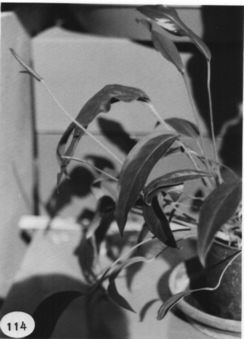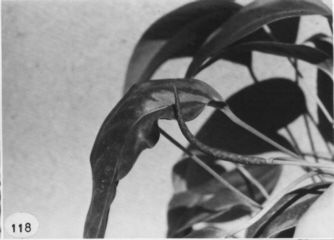





Type Code. On the Atlantic slope near the Continental Divide along lumbering road above El Copé, 9.4 km, N of El Copé (2.2 km N of lumber sawmill), 8°37'N, 80°36'W, Croat 44670 (MO 2909689, holotype; PMA, isotype; Live at MO).
Epiphyte; stems green, less than 10 cm long, 1 cm diam.; leaf scars moderately conspicuous, ca. 5 mm wide; roots spreading, short, green to purplish brown in age; cataphylls thin, 2-2.5 cm long, acuminate at apex, drying tan, weathering and persisting more or less intact, deciduous at lower nodes.
LEAVES spreading; petioles terete, 11-20 cm long, 2-3 mm diam.;
geniculum 1-1.5 cm long, scarcely thicker or paler than petioles; blades
lanceolate, subcoriaceous, gradually to abruptly acuminate at apex (the
acumen apiculale), obtuse to subrounded at base, 9-17 cm long, 2.7-6.3
cm wide, usually broadest in the lower third: both surfaces semiglossy,
the upper surface eglandular, the epidermal cells convex, the lower surface
dark glandular-punctate; mid ribb raised at base above, sunken at apex,
raised below; primary lateral veins 4÷5 per side, departing midrib at ca.
45° angle, straight to collective vein, scarcely sunken above, prominulous
below, lesser veins scarcely visible above and below: collective vein arising
from the base, 4-6 mm from margin.
INFLORESCENCE spreading. as long as or longer than leaves; peduncle
terete. 15-28 cm long, 1.5-2.5 mm diam., equalling or up to one and a half
times longer than petioles: spathe moderately thin, medium green, lanceolate,
3-3.5 cm long, 7-8 mm wide, broad-;si just above base, acuminate at apex,
rounded at base, the margins turned up, inserted at 90° angle on peduncle;
stipe ca. 3 mm long in front, ca- 2 mm long in back, ca. 2.5 mm diam.;
spadix olive green (B & K Yellow-green 5/5-5/7.5), sometimes becoming
tinged with violet purple, 4-7.5 cm long, 4.5-5 mm near base, tapered to
less than 1 mm at apex; the flowers square, 4-4.7 mm in both directions,
the sides straight parallel to the spirals, weakly sigmoid perpendicular
to the spirals, 2-3 flowers visible in the principal spiral, 5-6 flowers
visible in the alternate spiral; tepals semiglossy, lateral tepals 2.7-3.2
mm wide, the inner margin more or less straight; pistils emergent, weakly
raised, green; stigmas slit-like with minute exserted papillae; stamens
emerging promptly from base, laterals emerging first at least to middle
before alternates emerge, retracting promptly, usually with no more than
one stamen visible per flower at any time; anthers pale green, ca. 0.5
mm long, ca. 1 mm wide; thecae broadly ovoid, widely divaricate; pollen
white.
INFRUCTESCENCE to 11 cm long; berries orange, depressed-globose, ca. 4 mm long, 5 mm diam.; seeds usually 4, 2-2.5 mm long, 1-1.2 mm diam., weakly flattened. Figs. 114 and 118.
Anthurium oxystachyum is endemic to Code Province in Panama at about 900 m in premontane rain forest. The species is in section Porphyrochitonium and is distinguished by its more or less lanceolate leaf blades that are mostly obtuse to subrounded at the base and are glandular-punctate on the lower surface and especially by its slender, sharply tapered, green spadix. The name refers to the sharply tapered spadix ("oxys" from the Greek for sharp). It is most similar to and perhaps inseparable from Anthurium crassiradix, which has a similar sharply tapered spadix and flowers, but the latter species has thicker blades with the veins etched on the upper surface and is more conspicuously glandular-punctate on the lower surface. In addition, it has a peduncle that is conspicuously ribbed.
Anthurium oxystachyum is also similar to A. gracilispadix from Chiriquí Province, which shares a similar sharply tapered spadix, but that species has the upper blade surfaces conspicuously glandular-punctate.
 |
 |
Map of Mesoamerican specimens with coordinates
Panama : 1450-1480 m, 8.35N 81.50W, 6 July 1988, Thomas B. Croat 69016
(MO).
Panama : 1500 m, 8.35N 81.50W, 8 July 1988, Thomas B. Croat 69213 (MO).
Panama Chiriquí: 1200-1300 m, 8.45N 82.15W, 25 Apr 1988, Thompson 4964
(CM).
Panama CoclŽ: 800 m, 08.39N 80.36W, 31 March 1993, Thomas B. Croat
75102 (MO).
Panama CoclŽ: 750-900 m,, 20 Jan. 1978, Thomas B. Croat 44670 (MO).